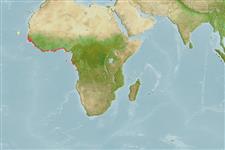>
Carangiformes (Jacks) >
Carangidae (Jacks and pompanos) > Trachinotinae
Etymology: Trachinotus: Greek, trachys, -eia, -ys = rough + Greek,noton = back (Ref. 45335).
More on author: Cuvier.
Environment: milieu / climate zone / depth range / distribution range
ນິເວດວິທະຍາ
ສັດທະເລ; ນ້ຳຈືດ; ນ້ຳກ່ອຍ. Tropical; 28°N - 7°S
Eastern Atlantic: Senegal to Gabon, including Cape Verde (Ref. 4225, 57392, 81654).
Length at first maturity / ຂະໜາດ / ນ້ຳໜັກ / Age
Maturity: Lm 29.0 range ? - 42 cm
Max length : 68.0 cm TL ຕົວຜູ້/ບໍ່ມີເພດ; (Ref. 57392); common length : 35.0 cm TL ຕົວຜູ້/ບໍ່ມີເພດ; (Ref. 26999); ນ້ຳໜັກສູງສຸດທີ່ເຄຍຈັດພີມມາ: 8.3 kg (Ref. 126428)
ຄີ (ໜາມ)ແຂງຢູ່ຫຼັງປາ (ທັງໝົດ) : 7; ຄີຫຼັງຂອງປາ (ຄີອ່ອນ) (ທັງໝົດ) : 19 - 21; ຄີ(ໜາມ) ແຂງຢູ່ຄີກົ້ນປາ
ກຸ່ມປາກະດູກແຂງ
ຄວາມຖີ່ຂອງກຸ່ມຖ່າຍທອດພັນ
ປາທີ່ມີການເຄື່ອນຍ້າຍຈາກທະເລໄປຫານ້ຳຈືດ ແລະນ້ຳຈືດຫາທະເລ
ປາທີ່ມີການເຄື່ອນຍ້າຍຈາກທະເລແລະໄປໄຂ່ຢູ່ນ້ຳຈືດ
ຄີກົ້ນຂອງປາ
ສັດທີ່ມີກະດູກສັນຫັຼງ
ການຖ່າຍທອດທາງກຳມະພັນຈາກພໍ່ແມ່ຫາລູກ: 3; ຄີກົ້ນຂອງປາ: 16 - 18. Diagnosis: body short and deep (depth comprised 1.8-2.5 times in fork length)(Ref. 57392, 81654). Snout rounded; mouth small; maxillary reaching to below hind margin of pupil (Ref. 57392). No teeth on tongue (Ref. 81654). 2 dorsal fins, 1st with 6 spines, 2nd with 1 spine and 19-21 soft rays; anal fin with 2 short, detached spines followed by 1 spine and 16-18 soft rays (Ref. 57392, 81654). Soft dorsal (Ref. 57392, 81654) and anal fin lobes shorter than head (Ref. 57392). Pectoral fins short; scales small, cycloid and partially embedded in skin; lateral line very slightly arched over pectoral fins, without scutes (Ref. 57392). No distinct spots/dark blotches (Ref. 57392, 81654) or other colour marks on body (Ref. 57392).
Coloration: back bluish-grey or greenish, sides and ventrum silvery, without distinctive markings; fins dark; lobes of dorsal, anal and caudal fins darker to black (Ref. 57392, 81654).
Adults inhabit coastal waters (Ref. 2683). Enters brackish waters for reproduction and ascends rather far up the lower courses of rivers (Ref. 4225, 57392). Unique in spending the whole live cycle in myxohaline environment, without a marine phase; seasonality of recruitment seems to indicate that favourable conditions for reproduction and larval survival are limited to the dry season although sexual maturity occurs all year round (Ref. 81654). Feeds on fry and young shrimps up to 125 mm fork length, diet of larger specimens mainly malacophagous (bivalves), the shells of which are crushed with well-developed pharyngeal jaws (Ref. 81654). Also feeds on fish, shrimps and crabs (Ref. 28587). Maximum fork length recorded was 610 mm (Ref. 57392).
Life cycle and mating behavior
ການຈະເລີນເຕັມໄວ | ການສືບພັນ | ການວາງໄຂ່ | ໄຂ່ | ຄວາມດົກຂອງໄຂ່ປາ | ຕົວອ່ອນ
Bauchot, M.-L., 2003. Carangidae. p. 464-483 In C. Lévêque, D. Paugy and G.G. Teugels (eds.) Faune des poissons d'eaux douce et saumâtres de l'Afrique de l'Ouest, Tome 2. Coll. Faune et Flore tropicales 40. Musée Royal de l'Afrique Centrale, Tervuren, Belgique, Museum National d'Histoire Naturalle, Paris, France and Institut de Recherche pour le Développement, Paris, France. 815 p. (Ref. 57392)
IUCN Red List Status (Ref. 130435: Version 2024-1)
Threat to humans
Harmless
Human uses
ການປະມົງ: ທີ່ເປັນການຄ້າໜ້ອຍ; ຊະນິດປາທີ່ຖືກນຳໃຊ້ເຂົ້າໃນການຫາເພື່ອເປັນເກມກິລາ: ແມ່ນ
ເຄື່ອງມື
Special reports
Download XML
ແຫຼ່ງອີນເຕີເນັດ
Estimates based on models
Preferred temperature (Ref.
123201): 23.6 - 27.9, mean 26.6 °C (based on 64 cells).
Phylogenetic diversity index (Ref.
82804): PD
50 = 0.5000 [Uniqueness, from 0.5 = low to 2.0 = high].
Bayesian length-weight: a=0.01738 (0.00903 - 0.03343), b=2.90 (2.73 - 3.07), in cm total length, based on LWR estimates for this species & Genus-body shape (Ref.
93245).
ຊັ້ນເຂດຮ້ອນ (Ref.
69278): 3.6 ±0.45 se; based on food items.
ຄວາມຢືດຢຸ່ນ (Ref.
120179): ຂະໜາດກາງ, ປະຊາກອນຕຳ່ສຸດທີ່ໃຊ້ເວລາສອງເທົ່າ 1.4 - 4.4 ປີ (Preliminary K or Fecundity.).
Fishing Vulnerability (Ref.
59153): Moderate to high vulnerability (47 of 100).
Nutrients (Ref.
124155): Calcium = 117 [52, 256] mg/100g; Iron = 1.39 [0.75, 3.00] mg/100g; Protein = 19 [17, 21] %; Omega3 = 0.2 [0.1, 0.4] g/100g; Selenium = 44.9 [20.3, 99.8] μg/100g; VitaminA = 9.36 [2.28, 33.15] μg/100g; Zinc = 1.06 [0.69, 1.66] mg/100g (wet weight);
